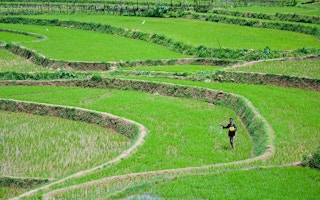A severe drought followed by heavy rainfalls in Sri Lanka has hit large swaths of cropping areas, threatening the food security of some 900,000 people, according to a report published last week by the Food and Agriculture Organization of the United Nations (FAO) and the United Nations World Food Programme (WFP).
According to the joint Crop and Food Security Assessment Mission, drought conditions in 2016 and early 2017 led to widespread crop failures, in particular for rice paddy - the country’s staple food. Total paddy production in 2017 is forecast at 2.7 million tonnes, almost 40 per cent less than the last year’s output and 35 per cent lower than the average of the previous five years.
Other crops, including various pulses, chillies and onion, which rely mainly on rainwater, were also heavily damaged by the dry weather.
The situation was exacerbated by subsequent heavy rainfalls in May. Floods and landslides in the south-western parts of the country caused deaths, large population displacements and damage to infrastructure. The rains did not ease the water supply constraints in the drought-impacted north-central and eastern parts of the country.
Now, nearly 225,000 households (or about 900,000 people) face food insecurity. The most vulnerable groups are struggling to earn an income after losing their own crops and have fewer employment opportunities.
In ten districts, a previous joint assessment showed that about one third of the drought-affected population had its regular income reduced by more than half, compared to the income generated from the 2015 to 2016 Maha season.
The situation may further deteriorate if the next cropping season fails. Due to a critical shortage of seeds and a lack of water for irrigation, the second 2017 paddy harvest - known as Yala, due to be harvested in August and September - is forecast at 1.2 million tonnes, 24 per cent below last year’s level.
Increasing food insecurity
Most families surveyed would usually grow their own food, but with the bad main harvest, many are now forced to buy food from local markets, where food prices have risen sharply. Rice prices reached an all-time high in January 2017 reducing the ability of families to access nutritious food.
Many of those affected have been forced to eat less. Interviews with households and market vendors showed that people were buying cheaper food whenever possible. Many reported a reduction in the purchase of meat and fish.
Urgent assistance required
To cover immediate needs, FAO and WFP call for the urgent provision of seeds as well as planting and irrigation equipment for the next Maha planting season from September to December, as well as support for irrigation systems.
The poorest and most vulnerable families should also quickly receive targeted cash assistance in order to ensure adequate food intake and to prevent families from incurring unsustainably high debt or adopting other coping mechanisms that affect them negatively over the longer term.
Recognising the increasing frequency of natural disasters affecting the agricultural sector and the impact on food security, it is also recommended to introduce longer-term measures to increase farmers’ and households’ resilience to natural disasters and climate change, such as promotion of drought tolerant crops and varieties and livelihood diversification.








